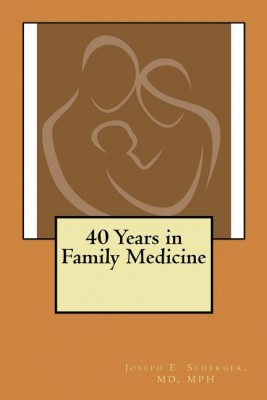| 40 Years in Family Medicine Contributor(s): Scherger MD, Joseph E. (Author) |
|
 |
ISBN: 1500604569 ISBN-13: 9781500604561 Publisher: Createspace Independent Publishing Platform OUR PRICE: $17.10 Product Type: Paperback Published: August 2014 |
| Additional Information |
| BISAC Categories: - Medical | Family & General Practice |
| Physical Information: 0.95" H x 5.98" W x 9.02" (1.37 lbs) 426 pages |
| Descriptions, Reviews, Etc. |
| Publisher Description: Dr. Joseph Scherger's career in family medicine started in the infancy of the new specialty in the early 1970s and went through its early transformation in the information age in Family Medicine. A typical general practitioner in office practice would see 50-60 patients a day. In family medicine, more time was spent with patients with an expanded focus on the patient's biopsychosocial needs. Family physicians between 1970 and 2000 were trained to see 20-30 patients a day. With the internet, communication and care with patients become continuously accessible and seeing patients in the office is a selective activity rather than the primary way patients are cared for. The emergence of health information technology and the internet will radically change the delivery of health care, and in 2014 these changes are still in their infancy. Collected here are the articles that he is most proud of and believes made some contribution to family medicine. The articles are not a complete look at the issues central to the growing specialty and academic discipline of family medicine during the 40 years between 1974 and 2014 but reflect those areas of his involvement, such as student interest in the specialty, especially during the 1970s and 1980s; family centered maternity care in the 1980s and 1990s; managed care in the 1990s; and the emergence of the internet and information technology resulting in new ways to provide family medicine in 2000 and beyond. Dr. Scherger did not plan to go into family medicine. Growing up in a small town in Northwest Ohio, Delphos, the only physicians were general practitioners. He was drawn to the social sciences and had a minor emphasis in philosophy while in college. While studying in the turbulent late 1960s, he said medicine would be my profession while philosophy would be my hobby. His conversion to family medicine happened during the third year of medical school at UCLA while on the emergency medicine rotation at a large county hospital. Each day the medical students were triaged to either the medical or surgical areas of the emergency room. On the surgical side he discovered he could fix things, such as sewing up lacerations, putting on splints and casts and loved it Being triaged to the medicine side, the tedium had him not looking forward to going in but that rotation was followed by the joy of delivering babies in obstetrics and seeing children in pediatrics. He wanted it all and was drawn to the new specialty of family medicine. Helping other medical students choose family medicine became a passion. Preceptorships, where students would spend time in a practicing family physician's office, became popular. He saw what experiences worked and the ones that turned the students off. That topic became the focus of his first published article and early presentations. He shared insight into how preceptorships were effective and why they were not. It is his hope that these articles are useful not only from an historical perspective but also as a guide to the future. |